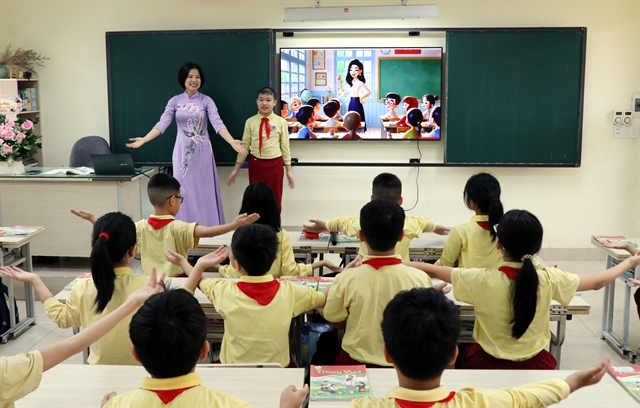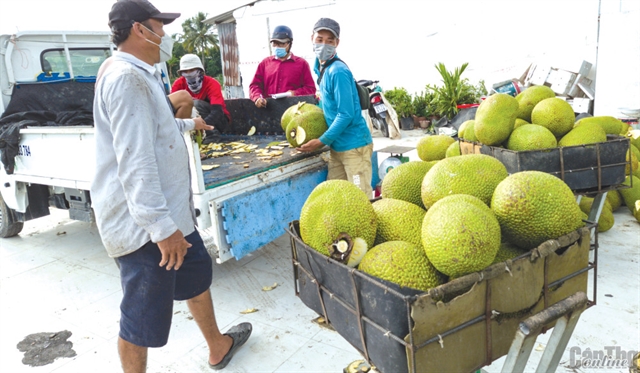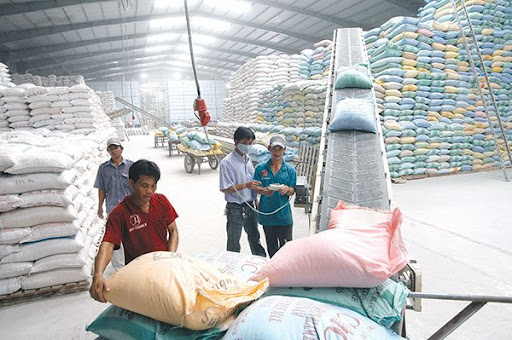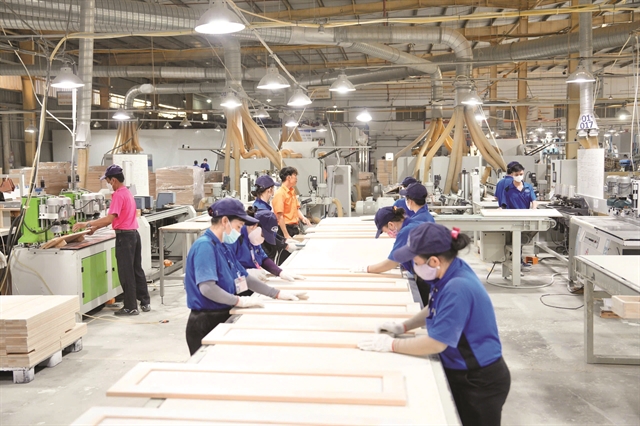 Society
Society

 |
| Traders buy jackfruit in Tiền Giang Province's Cai Lậy District. VNA/VNS Photo |
TIỀN GIANG — Agricultural and aquaculture cooperatives across Tiền Giang Province recorded total revenue of approximately VNĐ140 billion (about US$5.5 million) as of early June 2025, a year-on-year increase of nearly 25 per cent, according to Trần Hoàng Nhật Nam, Deputy Director of the provincial Department of Agriculture and Environment.
The province currently operates a network of 198 agricultural and aquaculture cooperatives, involving nearly 55,000 members and providing stable jobs for around 2,000 local workers.
These cooperatives are seen as key drivers of Tiền Giang’s strategy to develop a high-quality, market-oriented agricultural economy focusing on core competitive products such as premium rice, specialty fruits, and safe livestock products.
Depending on local conditions, cooperatives are scaling up effective production models to affirm the advantages of this new form of collective economy.
In Tiền Giang’s key rice-producing zones – the eastern and western regions – cooperatives have successfully partnered with enterprises to form large-scale rice fields.
During the 2024–25 Winter-Spring crop, nearly 3,000ha of rice were cultivated under such partnerships, yielding about 20,000 tonnes.
Three main models of partnership were adopted: businesses providing partial input materials and buying output; full input investment with guaranteed purchase; and output-only purchase agreements.
Under these linkages, the buying price offered to farmers ranged from VNĐ6,400 to VNĐ6,600 per kilogramme, around VNĐ600–900 higher than market rates.
Farmers earned net profits ranging from VNĐ20–30 million ($790–1,200) per hectare per crop, prompting strong enthusiasm among rural communities.
Successful cooperative models include Mỹ Trinh Agricultural Services Cooperative, Thiên Hộ General Agricultural Business Cooperative, and Mỹ Quới Agricultural Services Cooperative in Cái Bè District; Mỹ Thành Nam Agricultural Cooperative in Cai Lậy District; and Bình Nhì Rural Agricultural Services Cooperative and Phú Quới Agricultural–Commercial–Services Cooperative in Gò Công Tây.
Lê Văn Hưng, Director of Mỹ Thành Nam Agricultural Cooperative, said that in 2025, the cooperative will continue working with ADC Company (based in Cần Thơ City) to cultivate 100 hectares of high-quality rice under GlobalGAP standards.
 |
| Packing rice for export in Tiền Giang Province's Cái Bè District. VNA/VNS Photo |
The company will provide seeds, agricultural supplies, and cultivation techniques while committing to purchase the harvested rice at prices about VNĐ500 per kilogramme higher than market rates.
Particularly in the Gò Công area, the province has implemented a programme titled “Crop Diversification and Seasonal Transition for Eastern Districts through 2025”, resulting in the establishment of 37 new agricultural cooperatives with over 2,400 members.
Through these cooperatives, Tiền Giang has launched 12 production linkage projects under Government Decree No. 98/2018/NĐ-CP dated July 5, 2018, with total funding of over VNĐ32.4 billion ($1.27 million).
Of this amount, more than VNĐ6.6 billion came from the state budget, with the remainder contributed by private organizations and individuals.
Model cooperatives under this scheme include Gò Công Safe Vegetable Cooperative (Gò Công Đông), Thạnh Hưng Safe Vegetable Cooperative (Gò Công Tây), and Long Thuận Fruit and Vegetable Cooperative (Gò Công Town).
Through value chain linkages, these cooperatives supply an average of three to five tonnes of safe vegetables per day per cooperative, offering up to 36 vegetable varieties to local markets.
Trần Văn Bương, Director of Tân Đông Safe Vegetable Cooperative, said his unit includes 30 households cultivating vegetables under VietGAP standards on 13 hectares. Thanks to linkages with supermarkets, institutional kitchens, and wholesale markets, product consumption is stable and profitable. With an average of 10 production cycles per year and yields of up to 400 tonnes per hectare annually, revenue can reach VNĐ2 billion (US$78,000) per hectare per year, with farmers netting up to 50 per cent in profit.
Meanwhile, in the livestock and aquaculture sector, Nguyễn Quốc Kiệt, Director of the Gò Công Livestock–Aquaculture Cooperative, reported that the unit has been supplying around 80 tonnes of native Gò Công chicken annually, raised under VietGAP standards and distributed through contracts with supermarkets, restaurants, and food companies in HCM City.
The “Gò Công native chicken” brand has gained market recognition and earned a three-star OCOP (One Commune One Product) rating.
To further enhance cooperative effectiveness, Lê Minh Khánh, Vice Chairman of the Tiền Giang Cooperative Alliance, said the province is intensifying communication campaigns to raise awareness about the modern cooperative model among local authorities and the public.
Tiền Giang is also implementing a comprehensive support programme that includes preferential policies on land, finance, and credit, as well as infrastructure upgrades to improve processing and preservation capacities, support logistics systems, and facilitate trade promotion and market expansion.
In addition, the province is actively supporting training programmes for agricultural and rural occupations, safe production methods, high-tech applications, traceability systems, digital transformation in production and sales, and the expansion of effective value chain linkages.
These efforts aim to secure stable input and output markets for rice and other key products, thereby improving living standards for cooperative members.— VNS




